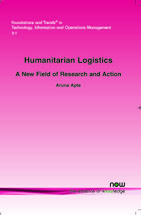Humanitarian Logistics: A New Field of Research and Action
By Aruna Apte, Graduate School of Business and Public Policy, Naval Postgraduate School, USA, auapte@nps.edu
Abstract
Recent natural disasters such as the earthquake in Haiti, Hurricane Katrina in the United States, tsunami in the Indian Ocean, the earthquake in Pakistan, and numerous humanitarian challenges arising from such conflicts as that in Sudan have exposed the shortcomings in planning for disasters. In addition to the natural disasters, the homeland security issues related to domestic as well as international terrorism have increased the fear factor and have made 'readiness' the principal priority. Humanitarian logistics is a critical element of an effective disaster relief process. The objective of this monograph is to discuss research issues and potential actions surrounding the new field of humanitarian logistics. We define humanitarian logistics as that special branch of logistics which manages response supply chain of critical supplies and services with challenges such as demand surges, uncertain supplies, critical time windows in face of infrastructure vulnerabilities and vast scope and size of the operations. We survey case studies to learn from the past experience and review analytical models from the literature to understand the state-of-the-art in humanitarian logistics. We recommend further research in the fields of operations management and operations research to improve the effectiveness and efficiency of humanitarian logistics. We conclude that though humanitarian logistics is inherently chaotic and complex, and it is difficult to do research in this area, the complexity and obstacles can be dealt with by the researchers.
Humanitarian Logistics
Humanitarian Logistics takes a comprehensive look at the issues surrounding humanitarian logistics through the life-cycle of the disaster spanning three stages of operations: preparation, disaster response, and humanitarian relief. The author defines humanitarian logistics from different perspectives, surveys case studies to delineate lessons learned, and reviews analytical models from the literature to understand the state of the art in humanitarian logistics. Humanitarian Logistics reviews the lessons learned in past humanitarian logistics efforts, develops a classification of disasters, and distinguish between disaster response and humanitarian relief. It examines the factors important for the design of humanitarian logistics using traditional concepts of logistics and supply chain management and compares humanitarian logistics with military logistics and commercial supply chains. It also describes supply chain issues and organizational issues in humanitarian logistics. The monograph concludes with the presentation of case studies of current practices that places this academic research in the context of reality and provides the broader picture of humanitarian logistics.
